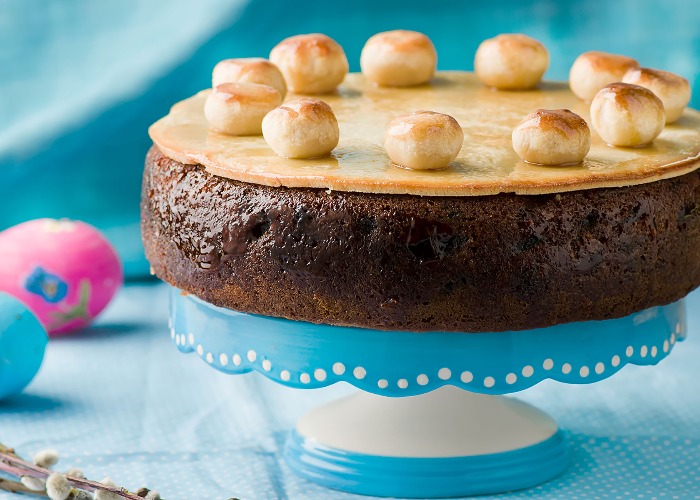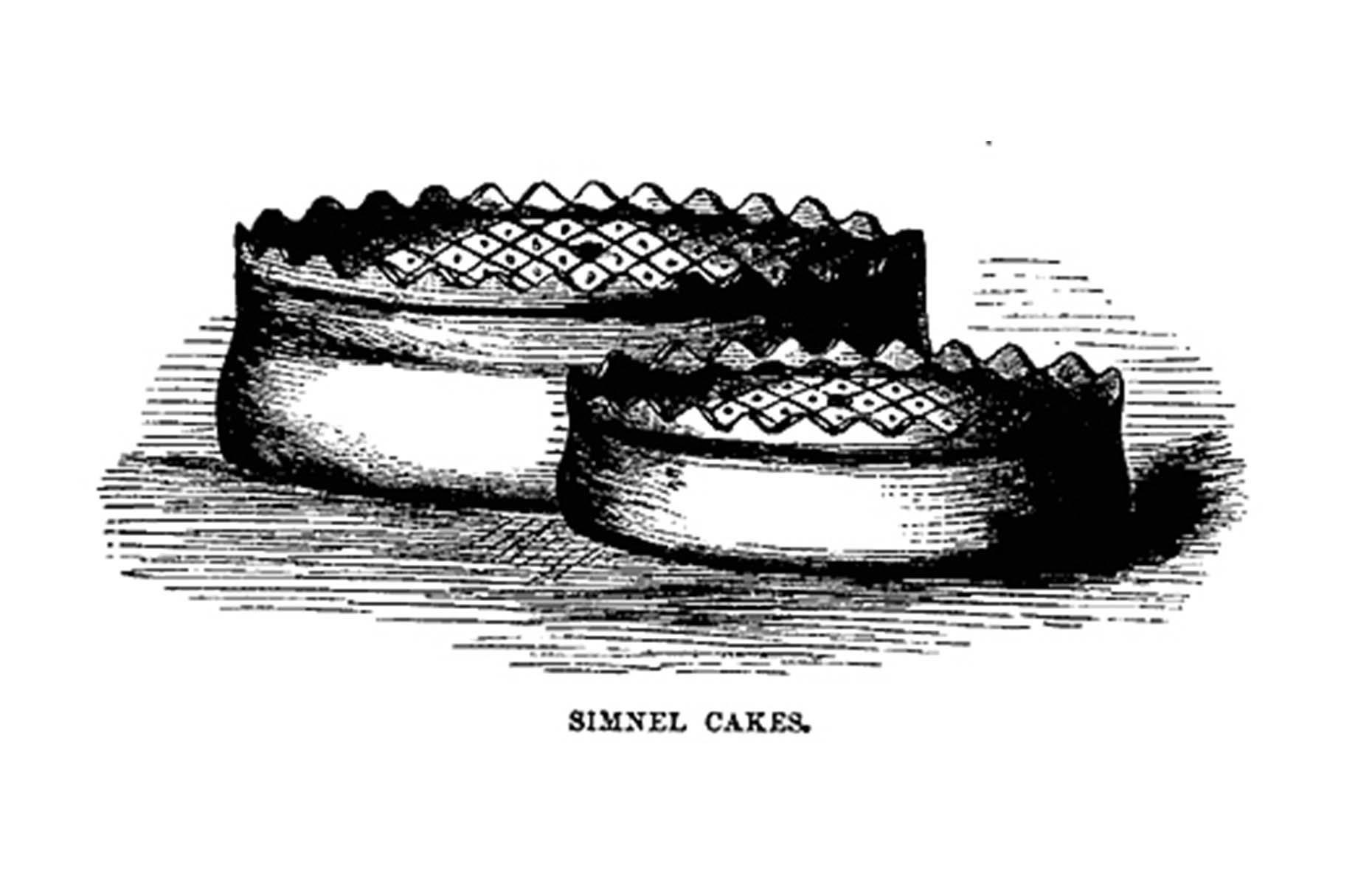Simnel cake: what is it, and what's the story behind it?

We delve into the mysterious history of simnel cake, as well as its symbolism and ties to the Easter table.
Fruitcake is famously associated with Christmas, but less well known – and equally delicious – is its springtime cousin, the simnel cake. Lighter, sweeter and steeped in symbolism, this Easter bake is also one of the UK's most mysterious traditional treats.
As food historian Dr Annie Gray puts it: “Simnel cake is the stuff of legends, most of them entirely unfounded in reality.” So what is the true story of the simnel? Let’s find out…
What is simnel cake?
The simnel cake we eat today is a light, almondy fruitcake made from white flour, sugar, butter, eggs, spices, dried fruit and candied peel. It has a layer of marzipan or almond paste baked into the middle, and orange flower water or brandy may be added to the cake batter or the filling.
What distinguishes it from other cakes is its decoration. Traditionally, simnel cake has another layer of almond paste or marzipan on top, and is adorned with 11 marzipan balls (representing the apostles, minus Judas). Edible flowers or Easter elements like toy chicks can be added as a final flourish.
READ MORE: Get our recipe for simnel cake here
 ClimbWhenReady/Shutterstock
ClimbWhenReady/Shutterstock
Where did simnel cake come from?
Simnel cake goes back centuries, but the one we eat today is very different from early bakes.
Museum curator Emma Heslewood, author of The Cake Historian blog, says: “There are other versions of simnel because it was originally a dough fruit bread. All cakes started life as sweet loaves and then evolved into textured cakes, when sugar became more readily available from the plantations. Before that, people might have used a bit of honey or fruit.”
So, where was simnel cake invented, exactly? There are three places that stake a claim – and although their recipes are quite different, each one omits milk and butter, as these used to be in limited supply during Lent.
The illustration below comes from a 19th-century book.
 Unknown/Wikimedia Commons/CC0
Unknown/Wikimedia Commons/CC0
Firstly, there's Shrewsbury simnel: a rich plum cake covered in a crust made from flour, saffron and water, giving it a distinctive yellow colour. Traditionally, this cake was boiled for several hours in a bag, like a Christmas pudding, then brushed with egg and baked – producing a solid, long-lasting result.
Emma says: “Shrewsbury is the first recorded one, but it could have been from anywhere really, as everyone made their own sweet breads and cakes.”
The second type is Devizes star simnel, a star-shaped cake made with currants and lemon peel, coloured golden with saffron, then boiled, baked and glazed. The Wiltshire Heritage Museum has an original recipe for the local version.
The third version is from the Lancashire town of Bury, and is closest to the simnel cake we eat today. This cake was made with nuts, cherries and peel, iced with marzipan and decorated with sugar balls. The town proudly promoted its cake in the 19th century, even presenting a 32kg (70lb) simnel to Queen Victoria in 1863 – which may be why the Bury take on simnel cake has become most common.
READ MORE: Amazing stories behind the world's favourite cakes and desserts
What does 'simnel' mean?
There are some weird and wonderful theories about how the cake got its name – and one of the most humorous is a 19th-century tale about an old couple called Simon and Nell.
Legend has it that they decided to use leftover ingredients from Christmas to make a cake for spring, but they argued over what to do with the dough. Simon wanted to boil it, and Nell wanted to bake it. They compromised by doing both, with their invention becoming known as a Sim-Nell.
It's also been suggested that the cake is named after Lambert Simnel, a claimant to the throne during Henry VII’s time. Victorian novelist Elizabeth Gaskell referenced this highly unlikely theory in a letter to a friend in 1838, when she shared her childhood recollections of eating simnel cake on Mothering Sunday in Knutsford, Cheshire.
READ MORE: The food and drink named after real people
 Patricia Chumillas/Shutterstock
Patricia Chumillas/Shutterstock
She wrote: “A cake made variously, but always with saffron for its principal ingredient. This I should fancy was a relic of Papistry, but I wonder how it originated. Lambert Simnel, the imposter in Henry the Seventh’s time, was a baker’s son, I think. The shop windows are filled with them, high and low eat them.”
The truth is actually far more pedestrian. Simnel probably comes from the Latin word ‘simila’, meaning fine wheat flour. The cake’s forefather, simnel bread, was a staple food in Britain as far back as the 11th century.
Why do we eat simnel cake at Easter?
Simnel is mostly eaten in the UK and countries with Christian populations descended from British and Irish immigrants. It was originally associated with feast days in Lent, including the fourth Sunday (known as Laetare Sunday), which also coincides with Mothering Sunday.
Today we regard Mother’s Day as a celebration of mums – but in Tudor times, it was a rare day off for servants, who used their free time to take cakes and flowers as gifts to their ‘mother’ churches.
Food historian Pen Vogler, author of Scoff: A History of Food and Class in Britain (£9.99, Atlantic Books), says simnel cake would have been made for the occasion, as it was a welcome respite from fasting. She notes that poet Robert Herrick wrote in 1648, "I’ll to thee a simnel bring, Gainst though go’st a mothering."
 GreenArt/Shutterstock
GreenArt/Shutterstock
However, Dr Annie Gray, a panellist on Radio 4’s The Kitchen Cabinet, and author of The Official Downton Abbey Cookbook (£18.39, Weldon Owen 2019), believes much of the symbolism around simnel cake is mythology, tracing it back to the Victorians who liked to tell 'tall stories'. Annie thinks the Mother’s Day connection is fairly modern, while marzipan balls only came into fashion in the 1970s, after briefly appearing in the Edwardian era.
Emma Heslewood agrees that the Victorians had a big hand in fixing the ‘cake calendar’. She says: “The 19th century was the height of cake eating, where the recipes were more formally established, like with Mrs Beeton, and cakes became traditional with the calendar.”
What is the truth?
Nobody knows – but what we can say is that simnel cake tastes and looks delightful. It might not be as popular as it once was, but with brands like Bettys and Marks & Spencer stocking the seasonal favourite, the cake could win hearts once more.
Emma says: “Perhaps the decline is because people don't celebrate Easter as much, or favour chocolate eggs instead. Fruitcakes have also declined in popularity because of the rise of American-style cakes – but simnel cake is a really beautiful cake that makes a wonderful centrepiece for your Easter celebrations.”
 Anna_Pustynnikova/Shutterstock
Anna_Pustynnikova/Shutterstock
Main image: zoryanchik/Shutterstock
Comments
Do you want to comment on this article? You need to be signed in for this feature